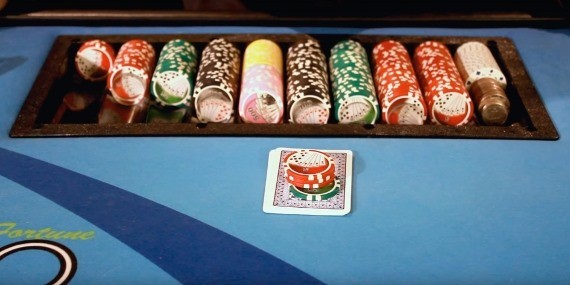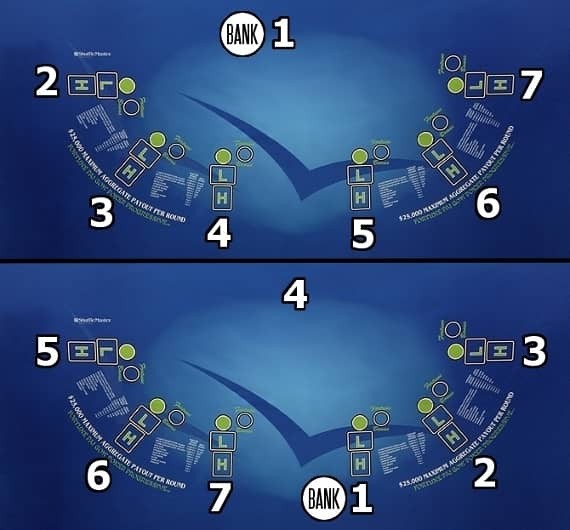Pai Gow Poker Commission Rules and How to Play as the Banker
How to Play Pai Gow Poker: Part 4
Table of Contents
How to Play Pai Gow PokerFurther Reading
- Part 1: Pai Gow Poker Basics and How to Set the Player Hand
- Part 2: Pai Gow Poker Foul Rules Dealer Hand Setting and How to Determine a Winner
- Part 3: Pai Gow Poker "House Way" Rules & Hand Rankings
- Part 4: Pai Gow Poker Commission Rules and How to Play as the Banker
- Part 5: Pai Gow Poker Dragon Hand Fortune Bonus and Envy Bonus Explained
- Part 6: Pai Gow Poker House Way Guide for Setting Hands
- Part 7: How to Play Pai Gow Poker at Home with Dice
Did this free course help you?
Click to leave a tip to help keep this resource free!
hubs:
- Pai Gow Poker series: name: How to Play Pai Gow Poker part: 4
Commission
Winning bets are charged a 5% commission which will be collected immediately by the dealer. This means that for every $5 the player wins they must pay a $0.25 commission. When calculating the math for commission, the dealer has two options. The first option is to take 10% of the bet and divide it by 2.
The second option is to memorize the basic chart and add the commissions as you go. So if you can remember that every $5 bet owes a $0.25 commission, every $20 bet owes a $1.00 commission and every $100 bet owes a $5 commission then you should be good to go.
Did you notice on the chart that both $1 and $5 bet is charged the same commission of $0.25? The reason why is because commissions are paid to the nearest quarter. Another word for this is “Breakage” which means when the amount is either rounded up or down in the casino’s favor. Breakage has a secondary meaning and it is, a policy casinos use to increase profits, by using math against the unsuspecting player. An example of breakage is, if the player bets $18, you can’t really ask them for a $0.90 commission on the extra $3; this is when breakage applies. If the player has a bet between $1 - $4, then the dealer will round up to the nearest $5 and charge them a $0.25 commission.
All players with winning bets are responsible for their own commissions. Normally, the dealer will just take the commission out of the player’s winning bet but if the player has the coinage then they may elect to pay the commission themselves instead. If that happens, then all winning payoffs must be sized into the bet and proven before any commission is collected.
Playing as Banker

“Banker” is just a title, given to a position, and it can be either a dealer or a player. When the player takes on the role as the banker, they’re called “Player-Banker”, and at the same time, the house will act as a player, even though the dealer will still handle all of the cards and cheques. The reason why someone would want to play as the Banker, is because the rules are slanted in favor towards the Banker. So when playing as Banker, the player is basically playing with zero house edge.
At the very beginning, the house will start off the round as Banker. Once the dealer has banked a hand, the Banker position will rotate around the table, starting from the dealer’s right hand side and going left.
A “Banker” button is placed in front of the betting circle to indicate who is banking, and because every casino is different, there are some casinos that will want the dealer to place the “Banker” button inside the betting circle. In these cases, the Player-Banker’s wager does not have to be inside the betting circle as long as the player has sufficient funds. Each player has the option to bank a hand or pass up the turn, and players are only allowed to bank one hand per rotation. The “Banker” button will always be in rotation, going back and forth between the players and the dealer. If there are no players who want to Bank, then the dealer will automatically be the “Banker” until there is a player who request to Bank. Every casino is different, but in Las Vegas, it’s okay for the player to bank, if it’s only themselves and the dealer at the table.
If a player wants to bank a hand, then they must have wagered on the previous hand, before they can qualify as Banker. The reason why the amount the player wagered on the last hand matters, is because both the player and the dealer must wager that same amount when the player is banking. Another thing the player must have to qualify for Banker is enough currency to cover all of the player’s bets on the table. This is because all of the other players, plus the dealer, are now playing against the Player-Banker; and the Player-Banker must have enough money to cover all of those bets. If there is any question of the Player-Banker’s ability to cover all bets, call over the floor.
The Player, acting as the Banker, must bank on the same spot as their previous wager. If the player had previously bet on two spots, than the spot with the very last wager played will be both the spot and wager used for banking.
a

After all of the bets have been placed, the dealer will lay out their “wager” last by placing it on the center of the table in front of the rack. If the table has a random number generator, then card placement will be determined by that, but if the table uses dice then the Player-Banker will be the one to shake the cup and expose the dice. When counting spots to determine who will get the first hand, make sure to start with the Player-Banker since the Banker spot is always #1, and then continue counter clock-wise. After the dealer gives himself a hand, he will place the house bet on top of the cards.

All of the other players on the table, except the Player-Banker and the dealer, will set their hand first. When everyone is finished, the Player-Banker is allowed to set their cards. Only when the Player-Banker is finished ranking their cards is the dealer finally allowed to set his hand. This is a good time to remind you that, unlike players, both the house and the player-banker cannot foul a hand. If a hand is set wrong by the player-banker then the house will take control of the hand and reset it the house way. If the dealer has to reset the hand, the Player-Banker is still financially responsible for the outcome of all the hands.
When the dealer has finished setting his hand, he will flip over the Player-Banker’s cards first, compare them with each other and then complete the take-and-pay procedure. If the Player-Banker beats the dealers hand then the dealer will leave their “wager” up on the center of the table and this is now the beginning of the Player-Banker’s bankroll. If the Player-Banker loses, then they have to pay the “wager” and the dealer will take the cheques and verify that it is the same amount before locking them up in the rack.
The dealer will place the houses cards in the discard rack before snatching up the Player-Banker’s cards and placing them in front of the dealer. Now that the Player-Banker’s cards are in front of the dealer, he will proceed as normal. Starting from the right hand side and going left, the dealer will compare the Player-Banker’s cards with the Players cards and if the hand is a tie, the bet is pushed and no money is exchanged. If the player loses, then the money is taken and placed in the Player-Banker’s bankroll, located at the center of the table. If the player wins, then the dealer will pay them from the bankroll, minus a 5% commission going to the house. If there is no money in the bankroll, then the Player-Banker will give the dealer the correct amount of money needed to pay the bet. At the end of the round, the remaining bankroll will be given to the Player-Banker, minus a 5% commission on the winnings.
Every casino is different, but in some casinos, when the player banks a hand, they have the option of requesting that the dealer co-bank with them. Co-banking means that the house will bankroll as partner for 50% of the declared player’s bet. The Player-Banker’s hand will be set the house way by the house dealer, which means the dealer will not receive a hand.
At a number of casinos, the Player-Banker will have the option to ask the dealer to sit out, which means that the house will not place a wager or play a hand. Now, I know what you dealers out there are thinking! This doesn’t mean that it’s a good time for the dealer to go take a smoke break, a coffee break, or any other kind of break! The dealer is still responsible for staying at the table, dealing the cards and collecting the 5% commission. At other casinos, the Player-Banker can ask the dealer to bet an amount less than the Player-Banker’s previous wager. In any case, the house minimum and maximum will always apply between the Player-Banker and all of the other players.
